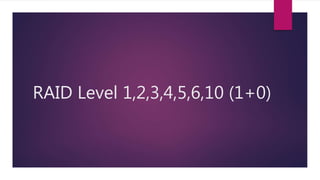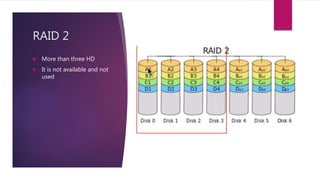3 configuring basic and dynamic disks
- 1. Configuration of Storage PREPARED BY HAMEDA HURMAT
- 2. Configuring Basic and Dynamic Disks Windows Server 2016 supports two types of disk configurations: Basic Dynamic Basic disks are divided in to partitions and can be used with previous versions of Windows. Dynamic disks are divided into volumes and can be used with Windows 2000 Server and newer releases When a disk is initialized, it is automatically created as a basic disk, Speed Fault-tolerance Redundancy
- 3. Fault-tolerance features and the ability to modify disks without having to reboot the server. A basic disk can simply be converted to a dynamic disk without loss of data. basic disk is converted, the partitions are automatically changed to the appropriate volumes. converting a dynamic disk back to a basic disk is not as simple. All the data on the dynamic disk must be backed up or moved. All the volumes on the dynamic disk have to be deleted. The dynamic disk can then be converted to a basic disk. Partitions and logical drives can be created, and the data can be restored. The following are actions that can be performed on basic disks.
- 4. The following are actions that can be performed on basic disks: Formatting partitions Marking partitions as active Creating and deleting primary and extended partitions Creating and deleting logical drives Converting from a basic disk to a dynamic disk The following are actions that can be performed on dynamic disks: Creating and deleting simple, striped, spanned, mirrored, or RAID-5 volumes Removing or breaking a mirrored volume Extending simple or spanned volumes Repairing mirrored or RAID-5 volumes Converting from a dynamic disk to a basic disk after deleting all volumes
- 5. Managing Volumes A volume set is created from volumes that span multiple drives by using the free space from those drives to construct what will appear to be a single drive. The following list includes the various types of volume sets and their definitions: Simple volume uses only one disk or a portion of a disk. Spanned volume is a simple volume that spans multiple disks, with a maximum of 32. Use a spanned volume if the volume needs are too great for a single disk. Striped volume stores data in stripes across two or more disks. A striped volume gives you fast access to data but is not fault tolerant, nor can it be extended or mirrored. If one disk in the striped set fails, the entire volume fails. Mirrored volume duplicates data across two disks. This type of volume is fault tolerant because if one drive fails, the data on the other disk is unaffected. RAID-5 volume stores data in stripes across three or more disks. This type of volume is fault tolerant because if a drive fails, the data can be re-created from the parity off of the remaining disk drives. Operating system files and boot files cannot reside on the RAID-5 disks.
- 6. Storage Spaces in Windows Server 2016 The Storage Spaces technology allows an administrator to have a highly available, scalable, low-cost, and flexible solution for both physical and virtual installations. Storage Pools are a group of physical disks that allows an administrator to delegate administration, expand disk sizes, and group disks together. Storage Spaces take free space from storage pools and create virtual disks called storage spaces. Storage spaces give administrators the ability to have precise control, resiliency, and storage tiers. One of the advantages of using the Storage Spaces technology is the ability to set up resiliency. There are three types of Storage Space resiliency: mirror, parity, and simple (no resiliency). Availability One advantage to the Storage Spaces technology is the ability to fully integrate the storage space with failover clustering. This advantage allows administrators to achieve service deployments that are continuously available. Administrators have the ability to set up
- 7. Redundant Array of Independent Disks The ability to support drive sets and arrays using Redundant Array of Independent Disks (RAID) technology is built into Windows Server 2016. RAID can be used to enhance data performance, or it can be used to provide fault tolerance to maintain data integrity in case of a hard disk failure. Windows Server 2016 supports three types of RAID technologies: RAID-0, RAID-1, and RAID-5. RAID-0 (Disk Striping) Disk striping is using two or more volumes on independent disks created as a single striped set. There can be a maximum of 32 disks. RAID-0 disk striping, you get very fast read and write performance RAID-0 does not offer the ability to maintain data integrity during a single disk failure. In other words, RAID-0 is not fault tolerant, a single disk event will cause the entire striped set to be lost, and it will have to be re-created through some type of recovery process, such as a tape backup.
- 8. RAID-1 (Disk Mirroring) Disk mirroring is two logical volumes on two separate identical disks created as a duplicate disk set. Data is written on two disks at the same time; disk failure, data integrity is maintained and available. fault tolerance gives administrators data redundancy, Price increase and the amount of available storage space by half.
- 9. RAID-5 Volume (Disk Striping with Parity) With a RAID-5 volume, you have the ability to use a minimum of three disks and maximum of 32 disks. RAID-5 volumes allow data to be striped across all of the disks with an additional block of error-correction called parity. Parity is used to reconstruct the data in the event of a disk failure. RAID-5 has slower write performance than the other RAID types because the OS must calculate the parity information for each stripe
- 11. RAID Level 1,2,3,4,5,6,10 (1+0)
- 12. • RAID 0 it is faster
- 13. RAID 1 Duplicate of each other Redundancy Reliability Only two Hard drive Expensive
- 14. RAID 2 More than three HD It is not available and not used
- 15. RAID 3 It content parity Minimum three drive It is also not used commonly
- 16. RAID 4 It used in linux
- 17. RAID 5 No extra Disk
- 18. RAID 6
- 19. RAID 10
- 20. Thank you !
- 21. Storage Practical Add more than 4 hard disk in virtual box Create simple, mirror and parity volume Add data in the drive Remove one hard disk in virtual box system





















